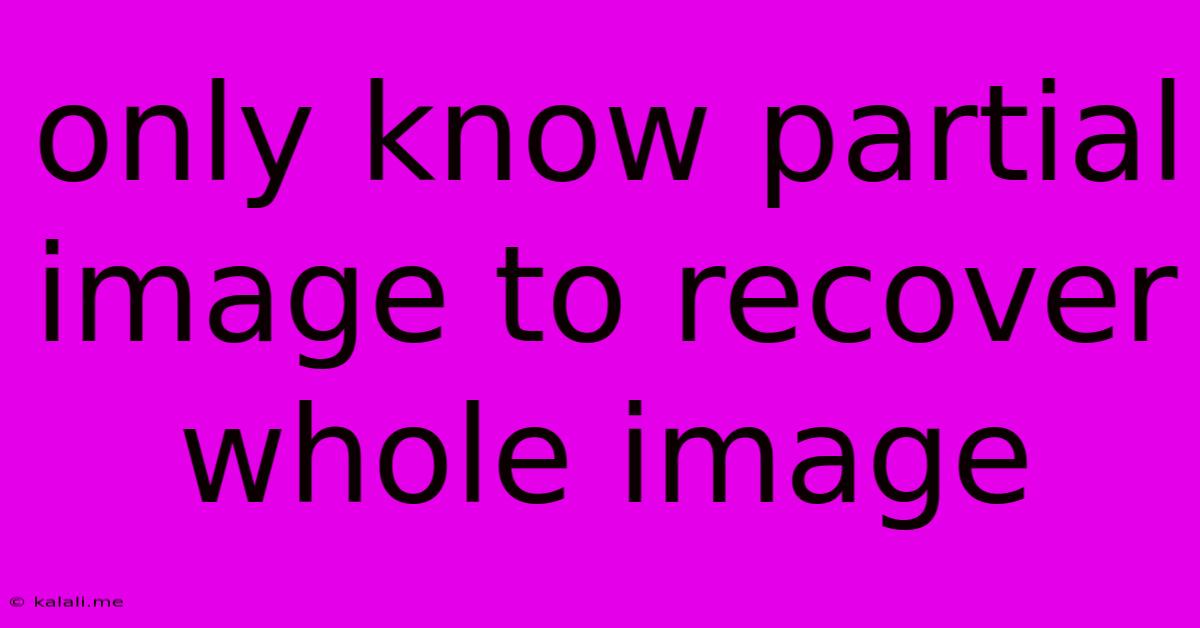Only Know Partial Image To Recover Whole Image
Kalali
Jun 03, 2025 · 3 min read

Table of Contents
Recovering a Whole Image from a Partial Fragment: Techniques and Challenges
Have you ever found yourself with only a piece of an image, desperately wishing you could recover the whole thing? Whether it's a damaged photo, a screen capture that's cut off, or a fragmented image from a corrupted file, recovering the missing parts can feel like an impossible task. This article explores the techniques and challenges involved in reconstructing a complete image from a partial fragment, examining the possibilities and limitations of this process.
Understanding the Challenges
The difficulty of recovering a whole image from a partial fragment depends on several key factors:
- The size of the missing portion: A small missing piece is significantly easier to reconstruct than a large one.
- The content of the missing portion: A missing area containing complex details or unique textures is harder to recover than a simpler, more uniform area.
- The quality of the available fragment: A blurry or low-resolution fragment will limit the accuracy of any reconstruction.
- The nature of the image loss: Was the image cropped, damaged, or corrupted? Different types of damage require different recovery techniques.
Methods for Image Recovery
Several methods can be used to attempt recovery, each with its strengths and weaknesses:
1. Image Inpainting
This technique uses algorithms to intelligently "fill in" the missing parts of an image based on the surrounding pixels. Sophisticated inpainting algorithms can analyze the texture, color, and patterns in the known areas to create a plausible reconstruction of the missing parts. This method works best for smaller missing areas and images with consistent textures. Tools offering inpainting capabilities are often found in advanced photo editing software.
2. Pattern Recognition and Repetition
If the missing portion contains repeating patterns or textures, such as a tiled floor or a repeating design, the algorithm can identify these patterns and extrapolate them to reconstruct the missing areas. This approach is highly effective when the missing area exhibits clear and easily identifiable repetitive elements.
3. Generative Adversarial Networks (GANs)
GANs are a type of artificial intelligence that can generate realistic images. By training a GAN on a dataset of similar images, it's possible to generate a plausible completion of the missing portion. This method is particularly effective for complex images but requires a large, relevant dataset for training. However, GANs can produce surprising and sometimes unexpected results, and the output may not perfectly match the original image's style.
4. Reverse Image Search
While not a direct reconstruction method, a reverse image search (using tools like Google Images or TinEye) can be incredibly useful. If the partial image contains unique elements, a reverse image search might reveal a full version of the image elsewhere online. This method relies on the existence of a complete version of the image somewhere on the internet.
5. Combining Methods
Often, the best results are achieved by combining multiple techniques. For example, you might use inpainting to fill in smaller gaps and then employ pattern recognition to reconstruct larger, more repetitive areas.
Limitations and Considerations
It's crucial to understand that perfectly recovering a complete image from a partial fragment is often impossible. The reconstructed areas will always contain some degree of uncertainty and may not perfectly match the original image. The accuracy of the reconstruction depends heavily on the factors mentioned earlier.
Conclusion
Recovering a complete image from a partial fragment presents a significant challenge, but advancements in image processing and AI offer increasingly sophisticated tools for tackling this problem. Understanding the limitations of these techniques and choosing the right approach for your specific situation is crucial for achieving the best possible results. The success of image recovery heavily depends on the nature of the image loss, the quality of the available fragment, and the complexity of the missing portion. Experimenting with different methods is often necessary to find the most effective solution.
Latest Posts
Latest Posts
-
Adding A Light To A 3 Way Switch
Jun 05, 2025
-
How Many Valence Electrons Are In Helium
Jun 05, 2025
-
How To Get Rid Of Red Ants In Yard
Jun 05, 2025
-
Is Freezer Paper The Same As Baking Paper
Jun 05, 2025
-
Can An Octopus Survive Out Of Water
Jun 05, 2025
Related Post
Thank you for visiting our website which covers about Only Know Partial Image To Recover Whole Image . We hope the information provided has been useful to you. Feel free to contact us if you have any questions or need further assistance. See you next time and don't miss to bookmark.